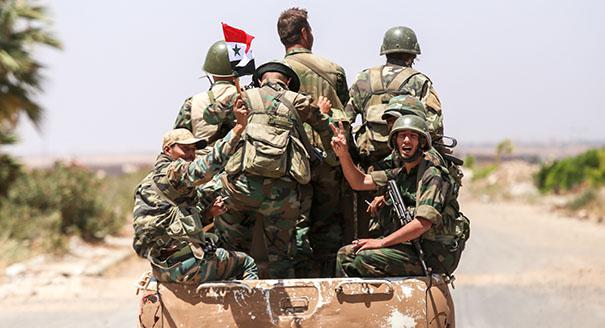Armenak Tokmajyan is a nonresident scholar at the Carnegie Middle East Center in Beirut, where his research focuses on borders and conflict, Syrian refugees, and local intermediaries in Syria. Recently, he published a paper for Carnegie, titled “How Southern Syria Has been Transformed Into a Regional Powder Keg.” In it, he examines the peculiar nature of the Syrian regime’s return to the south in 2018, and the situation that ensued. Diwan interviewed Tokmajyan in mid-July to discuss his paper and how he sees the dynamics in southern Syria developing.
Michael Young: You recently published a paper on the aftermath of the Syrian regime’s return to southern Syria in 2018, in particular Dar‘a and Quneitra Governorates. What is your argument?
Armenak Tokmajyan: I argue that despite the regime’s return in 2018 we cannot view Syria’s southern border area as a peripheral region in a sovereign country that is subjected to policies decided in Damascus. Rather, we should view it as a zone of regional contention where the interests of multiple local, regional, and international actors are converging and conflicting. In other words, the politics of this region are being forged primarily by regional, not sovereign, considerations.
Once we adopt that lens we notice that the peculiar political geography of the southern border region in 2018 imposed a delicate status quo, one largely set up and maintained by Russia during and after the military campaign that partially restored the regime’s presence in the south. At its core, this status quo aims at preventing the expanded presence of Iranian and pro-Iran military forces near the border, which could trigger a costly regional confrontation.
The future of this southern region will remain inextricably tied to the conditions imposed by the contentious border area. The status quo, for example, was a byproduct of this. But even if this status quo were to collapse or to be reshaped over time, whatever would emerge at the end of that process would do so in relation to the conditions imposed by the political geography of the border region.
MY: What is the current situation in the area covered in your paper?
AT: In short, more of the same. Many of the defining characteristics of southern Syria that I detailed in my paper continue to be true. For example, general insecurity persists, with new cases of kidnapping and assassination documented in the past month. The overall state of public services remains poor and there is a sharp increase in prices because of Syria’s economic crisis. On a more positive note, the regime has released some detainees, removed some 3,700 people from its wanted list, and promised to restore the status of public-sector employees, all key demands of the locals.
Another noteworthy development has been former rebels’ attempts to unite forces across Dar‘a. After the escalation in May 2020, when pro-Iran elements within the regime’s military forces were deployed to southwestern Dar‘a in an effort to boost the regime’s presence, talks took place behind the scenes between major former rebel leaders. Ahmad al-‘Audeh, Russia’s man in the south, hinted at this in a speech last month when he talked about plans to unify Dar‘a in “one body and one army,” without clarifying exactly what he meant. It remains to be seen how such unity will manifest itself, or if it will at all. Unity hasn’t been a defining characteristic of Syria’s rebels. But the importance of this attempt lies somewhere else. It seems to me that Russia, through its ally ‘Audeh, may be trying to shore up its influence on the ground, which could mean reinforcing the current situation.
MY: As you said, Russia played a key role in defining the nature of the Syrian regime’s return to the south. Can you tell us what are the long-term Russian interests in the border area? And how might they affect the parties on the ground?
AT: I think that Russia’s main long-term interest is to maintain its central role in shaping the regional dynamics that emerge in southern Syria. I tend to think that the Russians well understand that this region (at least for now) could not be treated as a periphery within a sovereign state, but rather had to be considered as a regional center in its own right. Their policies indicate this. In the south Moscow acts less as a regime ally and more as a guarantor of the regionally accepted status quo. It has not aided the regime, as it did in many other parts of Syria, to restore its firm security control, which, in turn, could have enabled Iranian expansion into the region. On the contrary, it has kept the regime’s presence weak and checked the Iranians. It has also extended a degree of protection to former rebel leaders and maintained the situation as is despite regime discontent. I believe that Russia has a strong interest in maintaining the existing state of affairs, and through that its central role in regional politics.
MY: You write that the dynamics in southern Syria will continue to have regional implications. Can you explain why and how long you think this will last?
AT: The volatility of Syria’s south is not just a concern for Syria but also for its neighbors, and even for actors that do not have common borders with Syria. Take the general insecurity in Dar‘a Governorate, for example. It has greatly worried Jordan for reasons that are tied to increased drugs and arms smuggling. This insecurity also hinders the return home of many Syrian refugees originating from Dar‘a who currently reside in Jordan.
Another telling example is Iran’s potential presence. If Iran or pro-Iran forces were to build up an offensive capability near the Israeli-occupied Golan Heights, this would jeopardize Israeli security and possibly lead to a confrontation. As I see it, the destabilizing conditions in southern Syria are here to stay.






